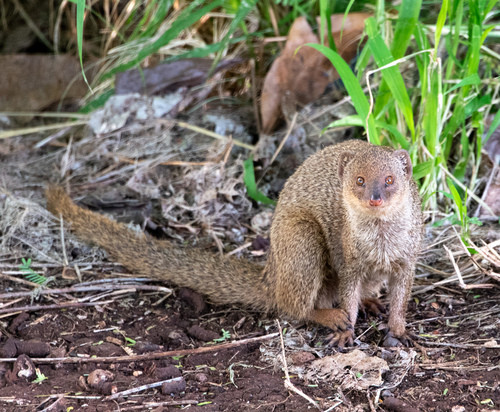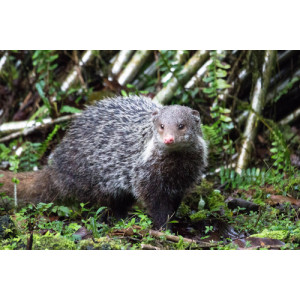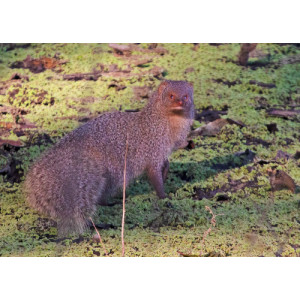Small Indian Mongoose Did you see this animal?
Scientific Name : Herpestes auropunctatus
Family : Herpestidae
Order : Carnivora
Class : Mammalia
Phylum : Chordata
Habitat : Forest, Shrubland, Grassland
Description : The small Indian mongoose is a small, slender, carnivorous mammal with a pointed snout and a long, bushy tail. It typically measures 30-45 cm in length, excluding the tail, and weighs around 0.5-1.5 kg. It has a sleek, reddish-brown to grayish-brown coat with lighter underparts and black or brown legs and feet.
The small Indian mongoose is found in a wide range of habitats, including forests, grasslands, farmlands, and urban areas. It is a highly adaptable species and can thrive in both natural and human-modified environments.
The small Indian mongoose is a carnivore and feeds on a variety of prey, including insects, small reptiles and amphibians, rodents, birds, and eggs. It is also known to consume fruits and other plant material.
The small Indian mongoose is a solitary animal and is active during the day. It is a skilled hunter and is known to be very agile and quick, allowing it to catch fast-moving prey. It is also a good swimmer and climber.
The small Indian mongoose breeds throughout the year, with females giving birth to litters of 2-5 young after a gestation period of around 49-62 days. The young are born blind and helpless and are cared for by the mother until they are able to fend for themselves.
The small Indian mongoose is listed as a species of "least concern" by the International Union for Conservation of Nature (IUCN), due to its wide range and adaptability to various habitats. However, it has been introduced to many parts of the world where it has become invasive and is considered a threat to native wildlife.
The small Indian mongoose is found in a wide range of habitats, including forests, grasslands, farmlands, and urban areas. It is a highly adaptable species and can thrive in both natural and human-modified environments.
The small Indian mongoose is a carnivore and feeds on a variety of prey, including insects, small reptiles and amphibians, rodents, birds, and eggs. It is also known to consume fruits and other plant material.
The small Indian mongoose is a solitary animal and is active during the day. It is a skilled hunter and is known to be very agile and quick, allowing it to catch fast-moving prey. It is also a good swimmer and climber.
The small Indian mongoose breeds throughout the year, with females giving birth to litters of 2-5 young after a gestation period of around 49-62 days. The young are born blind and helpless and are cared for by the mother until they are able to fend for themselves.
The small Indian mongoose is listed as a species of "least concern" by the International Union for Conservation of Nature (IUCN), due to its wide range and adaptability to various habitats. However, it has been introduced to many parts of the world where it has become invasive and is considered a threat to native wildlife.
Distribution in Bangladesh
References:
description written by:Asad U. Tanvir,Department of Zoology,Jagannath University,Dhaka; reviewed by:Muntasir Akash,Department of Zoology,University of Dhaka;Taxonomic Checklist:Red List of Bangladesh Volume 2: Mammals, 2015, IUCN; information sources:iucnredlist.org,Khan 2018 (Photographic guide to the wildlife of Bangladesh), photo credit:Samiul Mohsanin, (Jahangirnagar University,Dhaka), photo copyright: Samiul Mohsanin.more information please contact with us.
description written by:Asad U. Tanvir,Department of Zoology,Jagannath University,Dhaka; reviewed by:Muntasir Akash,Department of Zoology,University of Dhaka;Taxonomic Checklist:Red List of Bangladesh Volume 2: Mammals, 2015, IUCN; information sources:iucnredlist.org,Khan 2018 (Photographic guide to the wildlife of Bangladesh), photo credit:Samiul Mohsanin, (Jahangirnagar University,Dhaka), photo copyright: Samiul Mohsanin.more information please contact with us.






























